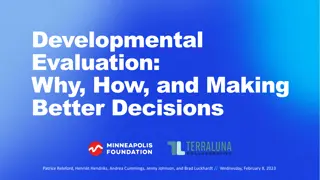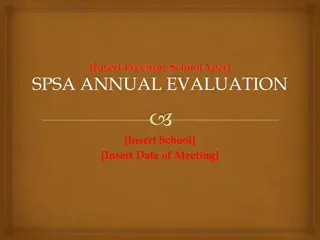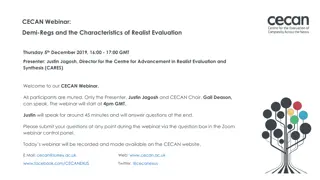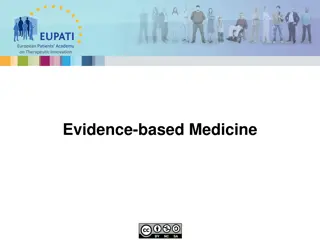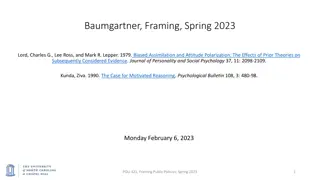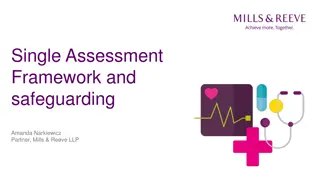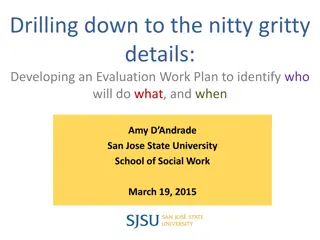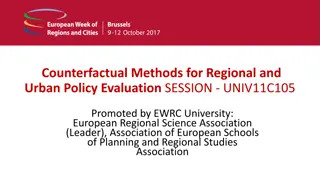Understanding Impact Evaluation for Evidence-Based Development
Explore the importance of impact evaluation in policy-making, the difference between monitoring and impact evaluation, and the significance of causal inference and counterfactuals in assessing project effectiveness.
Download Presentation

Please find below an Image/Link to download the presentation.
The content on the website is provided AS IS for your information and personal use only. It may not be sold, licensed, or shared on other websites without obtaining consent from the author. Download presentation by click this link. If you encounter any issues during the download, it is possible that the publisher has removed the file from their server.
E N D
Presentation Transcript
IsDB-World Bank DIME Impact Evaluation Event Dakar, Senegal January 29-31, 2019 Transforming Development through Evidence-Based Policy Non Non- -experimental methods for transport impact experimental methods for transport impact evaluation evaluation Dakar, Senegal | January 29-31, 2019
overview In this sessions, we will discuss: the logic of impact evaluation The various methods of non-experimental impact evaluation A case study, to which all major non- experimental methods will be applied
overview Today: non-experimental methods for impact evaluation Tomorrow: randomized controlled trials (RCTs) Wednesday: sampling and power calculations for impact evaluation
Why impact evaluation? We want to implement the most effective policies and programs So we need a method that enables us to understand what works and what does not work The means we need to understand cause and effect We must measure what happened We must also find a way to measure the counterfactual (what would have happened if we had not implemented the program)
M&E versus impact evaluation Monitoring and evaluation Tracks whether project activities were conducted (inputs) Counts the project outputs that were delivered/constructed Was the road built? Was it on time, and did it meet technical standards? Are people/vehicles using the road?
M&E versus impact evaluation This standard M&E approach remains very important But it does not tell us: Did the road lead to increased economic growth/reduced poverty? What is the most precise estimate of this economic growth? How does it compare to alternate uses of scarce resources? Did all groups benefit? Were their winners and losers? To what extent?
Causal inference and counterfactuals Fundamentally, to know the effect of our project, we want to observe something that is fundamentally unobservable: the counterfactual What happened to the village where we built a road, compared to what would have happened to the same village if we did not build the road
Causal inference and counterfactuals Since we can never observe the same village at the same time both with and without the road, we must use other methods to develop a valid comparison group
impact evaluation A historical example: Did the expansion of railways in the late 19th century US contribute to economic growth? The Fogel hypothesis:
Building a road (or a railroad) is probably a good thing. But how good, relative to other investments? the level of per capita income achieved by January 1, 1890 would have been reached by March 31, 1890, if railroads had never been invented. Source: Lance Davis, https://eh.net/book_reviews/railroads-and-american- economic-growth-essays-in-econometric-history
By contrast, new data sources and methods give a very different answer. (Donaldson and Hornbeck 2016)
New York Times, June 8, 2017: the Fogel hypothesis revisited?
Case study The Republic of Atlantis is planning a rural road rehabilitation program Agricultural households cannot sell goods at market because poor roads, high transport costs no profit for cash crop production If you fix the roads, they can produce and sell crops at market -- > higher household incomes and consumption, less poverty
Case study: the program First they class all villages into groups: 9,000 villages in the country qualify as high priority for road rehabilitation Given budget limits, the Dept of Transportation opens up the program to 2,000 villages and invites them to apply. Eligible villages must apply by a certain date, otherwise cannot receive program By program deadline, 1,021 villages have applied out of 2,000 these villages receive the program
Case study: the evaluation Minister of Finance: Roads are expensive if they want this program to be scaled up, he wants evidence on the economic return So the team consults with researchers at Atlantis National University on how to design an evaluation that can inform this decision What is the main question that they must answer with this evaluation?
Case study: the evaluation Project team has done detailed M&E on previous projects Tracked that roads were actually built up to standard in project villages Also measured that, in project villages: travel time to market centers decreased Vehicle operating costs for car owners decreased Did it have any effect incomes or poverty?
Case study: the evaluation Based on conversation with evaluation team, they improve methods: Collect information not just about travel times, but collect detailed household consumption data from households They collect this data in both the program villages ( treatment ) and the comparison villages
Method 1: Single difference treated villages comparison villages Estimated Impact 301.6 219.1 82.5* Average per capita consumption (Atlantis dollars) * = statistically significant at 5% level
Method 1: Single difference What does this method tell us about the impact of road upgrading on households welfare?
Method 1: Single difference Is it possible that the villages that are part of phase one are different from those that did not? If so, in which ways?
Method 1: Single difference Method 1: Simple Difference Treatment Comparison Difference Number of users 44.26 31.83 12.43* Pop. density 111.90 109.46 2.44* Local market [1= Yes] 0.86 0.85 0.01 Number of children per HH 4.83 5.27 -0.44* Diversification (%) 25.90 25.33 0.57 Sample size 1021 979
Method 2: matching To address these issues, we can us an approach called matching (or propensity score matching) Use what you know about the villages (observable characteristics) to create treatment and control groups that are similar on these characteristics.
Method 2: matching Based on what we know about the villages, (population, distance to market, etc), we estimate a probability that they participated in the program. Example: for each village in treatment group with a (25%/50%/75%) probability of participation, you include one in the control group with (25%/50%/75%) probability of participation
Method 2: matching Result: matched treatment and control groups which are similar across a broad range of characteristics but which differ on whether or not they took part in the program
Method 2: matching Method 1: Simple Difference Method 2: Propensity Score Matching Treatment Differen ce Comparison Difference Treatment Comparison Number of users 44.26 31.83 12.43* 43.31 34.18 9.13* Pop. density Local market [1= Yes] 111.90 0.86 109.46 0.85 2.44* 0.01 111.40 0.86 110.14 0.85 1.26 0.02 Number of children per HH 4.83 5.27 -0.44* 4.95 5.18 -0.23* Diversification (%) 25.90 25.33 0.57 26.01 25.41 0.60 Sample size 1021 979 886 751 * = statistically significant at 5% level
Method 2: matching From Table 2, what do you notice about the difference in observable characteristics between the treatment and comparison groups when you switch from using Method 1, Simple Difference, to Method 2, Propensity Score Matching? Why do you think that is?
Method 2: matching Treated villages Comparison group Estimated Impact 290.23 234.41 55.8* Average per capita consumption (Atlantis dollars)
Method 2: matching Why do you think that the estimated impact of the upgrading using Method 2 is smaller than the impact estimated using Method 1?
Method 2: matching Notes: This only accounts for observable traits May lose sample size (e.g if you have villages with 99% probability in treatment group but none in control, these will be dropped, and vice versa)
Method 2: matching Propensity score for participants and non-participants Non-Participants Density Participants Common Support 0 1 Propensity score
Method 3: Difference-in-difference There is still the possibility that the two groups are fundamentally different The difference-in-difference method can help when this is the case. We measure household consumption before and after the program, and focus on the change over time, rather than the absolute difference
Method 3: Difference-in-difference We compare the difference between the change over time for both groups ?? = ?2016 ?2014 (?2016 ?2014). This means that even unobservable factors are accounted for, as long as they do not change over time in a way that is correlated with the program
Key assumption: parallel trends Treatment Effect
Method 3: Difference-in-difference TREATMENT upgraded villages COMPARISON Non upgraded villages Difference 301.6 219.1 82.5 POST-rural upgrading Consumption capita 2016 roads per PRE- upgrading Consumption per capita 2014 rural roads 274.4 219 55.4 PRE- upgrading Consumption per capita 2012 rural roads 273.4 218 55.4 27.1* Difference consumption per capita between 2016 2014 in (301.6-274.4)- (219.1-219) =(Difference-in- Difference) 27.2 0.1 and (301.6-274.4) (219.1-219)
Method 3: Difference-in-difference How could you use this data on consumption per capita in 2012 to improve your analysis? Based on the information in Table 4, what would be your new estimate of the impact of the rural road upgrades on consumption per capita? Compare your new estimate to the estimates you obtained with Methods 1 and 2. Is the estimated impact lower or higher? Why do you think this is?
Method 3: Difference-in-difference Extra notes Can also use triple difference matching + DD is a common method More powerful when there is significant data before treatment so trends can be examined (and controlled for). important weakness: Projects often deliberately targeted based on expectations of differential rates of change we targeted roads at villages with especially high potential for agricultural growth.
Method 4: Regression discontinuity (RD) Now imagine that instead of allocating the road project to villages that applied on time, the team instead ranked eligible villages based on relevant criteria such as poverty, distance to markets, condition of existing roads All 2,000 villages are ranked, and all villages with scores above some threshold receive the program, and those below it do not.
Method 4: Regression discontinuity (RD) Treatment and control will be very different in general, except immediately above and below the threshold Imagine that the cutoff is 500 Wealthy village near the capital = ranked 995 Poor remote village 1,000 km from capital = ranked 15 These cannot be meaningfully compared
Method 4: Regression discontinuity (RD) But what about villages 498, 499, 500, 501, 502? Presence above or below treatment threshold is essentially arbitrary, (close to) random. Villages 499 and 501 are likely very good comparators for each other
Method 4: Regression discontinuity (RD) Assignment to the treatment depends on continuous score or ranking observations ordered by looking at the score there is a cut-off point for eligibility clearly defined criterion determined ex ante cut-off determines the assignment to treatment
conclusions High quality non-experimental IE is data- intensive Advances in big data (remote sensing, high frequency/high resolution administrative data, new survey methods) are making this more feasible Many examples in forthcoming presentations
conclusions To design conduct high quality impact evaluations of major transport infrastructure projects, we may need the full toolkit of IE methods
conclusions In Phase 1 of ieConnect, we have IEs which have: A non-experimental component which estimates the impact of transport infrastructure (a road, a corridor, a BRT system) Complementary experimental interventions which test key components of program logic








